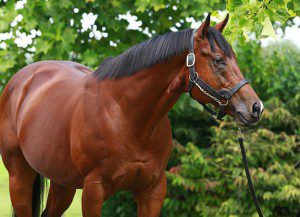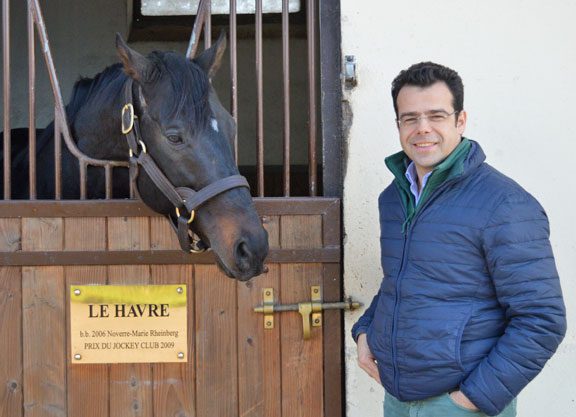By Kelsey Riley
In a time of positive transformation for the French breeding industry, the 2009 G1 Prix du Jockey Club winner Le Havre (Ire) (Noverre) has proven one of the greatest success stories. The former Gerard Augustin-Normand colorbearer was responsible for 13 stakes horses last year including Augustin-Normand's G1 Poule d'Essai des Pouliches and G1 Prix de Diane winner Avenir Certain (Fr) and G2 Prix Chaudenay victor Auvray (Fr), both of which hail from Le Havre's first crop and were therefore bred on a €5,000 stud fee. This year, Le Havre covered 199 mares at €20,000, and next year he will stand for €35,000.
The success of Le Havre and Cauviniere has not occurred by accident or a stroke of luck. Farm owners Sylvain and Elisabeth Vidal, as well as Mathieu Alex, who joined the management team in 2011, had accrued a wealth of international knowledge in the Thoroughbred business before opening the doors of the modern-day Cauviniere in 2006. Sylvain Vidal spent stints with the Niarchos family, Lane's End Farm in Kentucky and at Coolmore in Ireland, and it was in the latter role that he had Alex as a co-worker.
The Vidals purchased Cauviniere, a 250-hectare property between Lisieux and Orbec in Calvados, in 2006. The property, one of the oldest stud farms in France with history dating back about 200 years, had a 20-year hiatus in management prior to the Vidals's purchase, and they rebuilt much of the infrastructure including barns and fences. The farm now has four separate yards–a broodmare unit, two yearling yards and a stallion yard. The Vidals were supported from the start by Augustin-Normand, a financial analyst and president and chairman of Richelieu France.
 “The land was very good, because some very good show jumpers were bred here, but Sylvain and Elisabeth were more Thoroughbred-oriented, so they slowly developed it,” Mathieu Alex explained. “When Sylvain met Mr. Augustin-Normand, it was a big step forward.”
“The land was very good, because some very good show jumpers were bred here, but Sylvain and Elisabeth were more Thoroughbred-oriented, so they slowly developed it,” Mathieu Alex explained. “When Sylvain met Mr. Augustin-Normand, it was a big step forward.”
Le Havre was retired to Cauviniere in 2010, and Alex noted that Augustin-Normand, as well as Cauviniere and its client-base, strategically threw their support behind him from the start.
“Le Havre arrived and Sylvain and Mr. Augustin-Normand had a strategy that they had to buy mares to support him, and then everything went on and on.”
La Cauviniere is now home to three stallions. Air Chief Marshal (Ire) is a sprinting son of Danehill Dancer (Ire), who Alex pointed out is a stallion he admired from his time at Coolmore. He was represented by his first 3-year-olds this year and his second-crop 2-year-olds included stakes winner Rougeoyant (Fr), raced by Augustin-Normand. Air Chief Marshal will stand for €5,000 in 2016.
Group 2-winning miler Rajsaman (Fr) (Linamix {Fr}) is the youngest member of the roster, and his first yearlings have been well received in sales rings this year, making up to €67,000 off a €4,000 stud fee. Alex noted that they have made the rare decision to increase Rajsaman's 2015 fee despite the fact he hasn't had runners, simply due to demand: Rajsaman bred 219 mares this year from 300 applications.
Those numbers are not typical for a French stallion–Alex noted a good book size for a French sire would typically be around 80–but the team at Cauviniere are rewriting the rulebook in many ways. Alex pointed out that another tactic in Cauviniere's plan to make its stallions is to market them more heavily than is typically done in France–skills perhaps picked up on the team's overseas forays.
“I think it's working because of the numbers, and I think it's very important to welcome people any day,” Alex said. “This game is difficult and quite expensive, so you have to welcome [the clients], keep the horses looking well and take care of your clients.”
Alex did not rule out the Cauviniere stallion roster growing in the future, but he said it is important to stay at a number that allows the team to support each stallion heavily.
“You need to support them with some very good mares,” he said. “We're lucky enough to have some very good clients on the farm and we're buying some mares for these stallions to try to get the best mares possible. We keep as many of the progeny as we can in training and send them to the best French trainers and hope for the best, and we also buy yearlings by our stallions every year.”
“We're trying to do a lot of marketing, and it's our job to try to get the best mares to the stallions,” Alex added. “The marketing is very important, but also its important to support the stallions and believe in them. We could stand 10 more stallions, but we like the ones we have and they're a lot easier to sell when you like them and believe in them. We've been very lucky with Le Havre; he gave us a great start.”
Covering books in the 200-plus range is demanding on a stallion, and Alex noted they try to let the stallions live as naturally as possible and spend much time on pasture.
“They'll go out at 8 a.m. and come in at 3 or 4 p.m.,” he said. “During the breeding season, they would cover their first mare at 6:45 a.m., then at noon, later in the afternoon and at night, if necessary. They're young stallions so they can do it, and they don't do the dual-hemisphere.”
Alex said, however, that shuttling wouldn't be out of the question in the future.
“The door is open and we'd be keen to try to get Le Havre to New Zealand,” said Alex, who pointed out that he spent time with shuttlers in New Zealand in his Coolmore role. “He's been very busy the last few years so we just said we'd be careful with him.”
While Le Havre will stay home for the time being, he is expected to get about 50 mares from outside France in 2016. He will also get the support of some of Europe's most prolific breeders going forward; Le Havre was syndicated after Avenir Certain won the Prix de Diane last year, and his new ownership group includes the Aga Khan, the Wildenstein family, the Wertheimer brothers, the Niarchos family, Newsells Park Stud and Cheveley Park Stud. Augustin-Normand remains the majority owner.
 “It's important to try to guarantee some very good support every year,” Alex said, also pointing out that Le Havre presents something of a rare opportunity. “He's a great outcross–that Noverre, Blushing Groom line–there's not much left of it here in Europe.”
“It's important to try to guarantee some very good support every year,” Alex said, also pointing out that Le Havre presents something of a rare opportunity. “He's a great outcross–that Noverre, Blushing Groom line–there's not much left of it here in Europe.”
The future is bright for Le Havre, Cauviniere, and the country they inhabit. Alex noted that France's enviable premiums program has caused the quality of stallions in the country to improve, and has therefore drawn a higher-quality broodmare population. All this has helped business at Cauviniere.
“France has fantastic premiums, so we have some foreign clients that were interested in boarding mares here, so that's [helped us] develop,” he said. “We now have 120 mares on the property, including 40 owned by Mr. Augustin-Normand and 30 by the farm.”
Alex added, “We're very lucky now to have some very good stallions in France, so the stallions will bring a lot of energy into the country and attract outside mares. And because of the incentives most the foals will be born in France, so the whole system benefits from it.”
Click Here for a free daily subscription to TDN.
Not a subscriber? Click here to sign up for the daily PDF or alerts.




